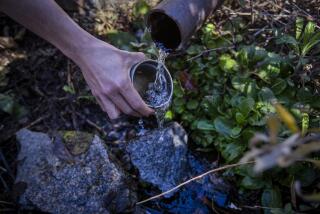Gabrielinos Join Battle Over Barrington Plaza : Zoning: Tribe may join Westside activists in effort to block 23-story development. They cite historical significance of underground springs.
The grand old trees were covered with graffiti, and the pond had more trash than lily pads, but Cindi Alvitre still found the springs at University High School a sacred place.
On a pilgrimage there Tuesday, the Gabrielino Indian knelt on the ground, cupped her hands and drank water bubbling up from springs that, centuries ago, were part of a village of her ancestors. “I can still feel the presence of my people,” she said. The visit was one more volley in the battle against Barrington Plaza, a proposed development 220 feet away.
Residents of West Los Angeles have fought the 23-story development at Wilshire Boulevard and Barrington Avenue, which would include a 262-room hotel, nearly 210,00 square feet of office space and nine stories of underground parking, because they say it would exceed density limits set for the property and would generate more traffic, sewage and pollution than the area could handle. Alvitre and her nearly forgotten tribe heard about the project and decided to join the battle against it.
About 5,000 Gabrielinos once lived in the Los Angeles Basin before Spanish conquerors, disease and, most recently, urban development, reduced their numbers to an estimated 400, tribal spokesman Robert Dorame said. Although the tribe is not federally recognized, members have managed over the years to remain united and have a tribal council that meets regularly.
The Gabrielinos, named after the San Gabriel Mission into which the Spanish herded them, fear that construction could destroy the underground springs that they say are of historical significance to them and the Spanish. Explorer Gaspar de Portola camped on the property Aug. 4, 1769, while traveling the route that became known as El Camino Real, and the missionary Padre Junipero Serra is believed to have said Mass there.
The Indians also fear that construction will further ravage a rich archeological site. Construction of University High School in 1925 unearthed the remains of an Indian village. In 1975, a science teacher from the school and a couple of students dug up more artifacts and some bones from what archeologists now believe is an Indian burial site.
West Los Angeles activists hope that they can form a partnership with the Indians to preserve the springs and stop the development. But the alliance is still fragile. Ernie Salas, a tribal spokesman, says many in the tribe do not yet trust the Westside activists and are hesitant to join their battle.
“We fear we’re being used as a front to stop developments,” Salas said. “It’s happened many times before. When it’s over, they say, ‘OK, you can go home now, Mr. Indian.’
“They’re not interested in our heritage. They’re interested in development.”
The Gabrielinos have asked the Westside activists for money to establish a cultural center near the springs in return for their opposition to the Barrington project. Jon Shaughnessy, a spokesman for the West L.A. Community Organization, said his organization has contacts that can help raise money for the Gabrielinos. Shaughnessy predicts that the two groups will work together, pointing to a rally scheduled Jan. 17 at the springs. Alvitre plans to bring other members of her tribe as well as a cultural exhibit. “It will be a sort of Thanksgiving dinner,” Shaughnessy said. Shaughnessy predicted that the partnership and the concerns raised by the Gabrielinos will bolster opposition to the project. “It could be another straw to break the camel’s back,” he said.
Public hearings on the project may begin as early as February.
More to Read
Sign up for Essential California
The most important California stories and recommendations in your inbox every morning.
You may occasionally receive promotional content from the Los Angeles Times.










